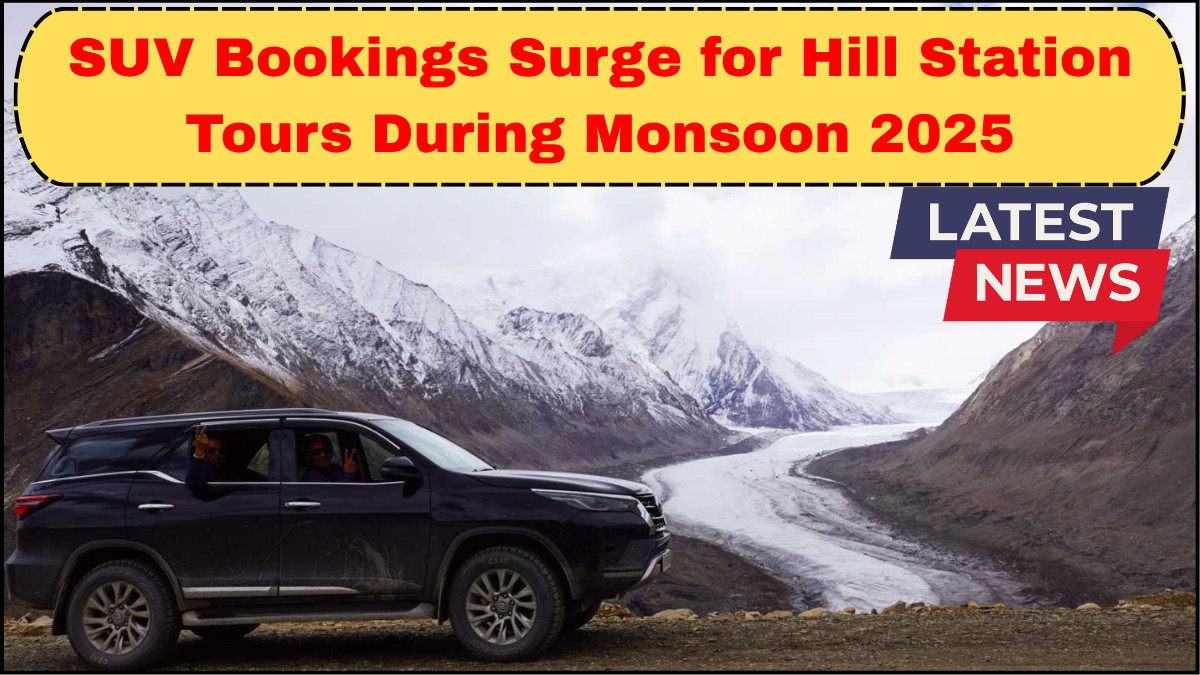As Monsoon 2025 sweeps across the Indian subcontinent, a sharp rise in SUV demand for hill stations is redefining seasonal travel patterns. Tour operators, car rental agencies, and self-drive platforms are witnessing an unprecedented surge in SUV bookings as tourists increasingly prioritize safety, comfort, and road capability while venturing into misty, mountainous terrain.
This seasonal shift is more than a spike—it’s a trend fueled by changing traveler preferences, infrastructure improvements, and a desire for immersive, offbeat travel experiences.

Why SUVs Are Dominating the Monsoon Travel Vehicle Trend
Monsoon travel comes with its own set of challenges: slippery roads, unexpected landslides, and poor visibility. In such conditions, the choice of vehicle becomes crucial. SUVs, known for their robust suspension systems, higher ground clearance, and superior traction control, have become the go-to option for travelers heading to elevated destinations.
Whether it’s the winding roads of Himachal, the lush green slopes of the Western Ghats, or the tea gardens of Assam, an SUV offers travelers both safety and convenience. This practical advantage is driving the monsoon travel vehicle trend, making SUVs the preferred choice for both families and adventure enthusiasts.
Self-Drive Rentals and Tour Packages Fueling the Demand
Platforms like Zoomcar, Revv, and Myles have reported a 40–60% increase in SUV bookings this monsoon season compared to last year. Many users are opting for self-drive options, seeking privacy and flexibility on their hill station tours. For those who prefer chauffeur-driven experiences, travel agencies are offering curated packages that include luxury SUV rides to lesser-known hill stations.
The ability to explore remote locations without the restrictions of public transport is further pushing the popularity of SUVs among monsoon travelers.
Hill Stations Becoming Monsoon Hotspots
Traditionally, hill stations see a tourist dip during the monsoon. However, 2025 has reversed that narrative. Places like Munnar, Coorg, Mussoorie, and Darjeeling are recording high footfalls despite intermittent rainfall. The misty landscapes, roaring waterfalls, and dewy trails are attracting a wave of eco-tourists, photographers, and content creators looking for fresh, green backdrops.
This growing attraction has resulted in travelers planning road trips as part of their itinerary, directly contributing to the SUV demand for hill stations.
Automakers and Travel Firms Capitalizing on the Trend
Automobile manufacturers are noticing this seasonal spike and tailoring their marketing campaigns accordingly. Companies like Mahindra, Toyota, and Hyundai are offering monsoon-specific leasing options and promotions for their SUV lineups.
Meanwhile, travel agencies are bundling SUV rides into monsoon tour packages, promising safer and more scenic journeys. From compact SUVs for couples to premium models for large families, the market is seeing demand across segments.
Safety and Tech Features Boosting SUV Appeal
Another reason for this spike is the inclusion of modern tech features in newer SUV models. With real-time GPS, terrain management systems, and AI-powered traction control, these vehicles offer much-needed support in treacherous monsoon conditions.
Many newer models also come equipped with rain-sensing wipers, hill-hold assist, and advanced driver-assistance systems (ADAS), enhancing both driver confidence and passenger safety.
Eco-Conscious Travelers Driving Hybrid SUV Demand
Interestingly, there’s also a visible shift toward hybrid and electric SUVs. Tourists are becoming more conscious of their carbon footprint. As a result, EV variants like the Tata Nexon EV and MG ZS EV are gaining traction among urban travelers heading to nature-rich destinations.
This crossover of sustainability and road performance is shaping the monsoon travel vehicle trend and redefining how India vacations during the rainy season.
Final Thoughts
The 2025 monsoon has turned into an SUV season for hill station explorers. With comfort, control, and capability at their core, SUVs are enabling travelers to reach breathtaking locales that would otherwise be inaccessible. This isn’t just a seasonal blip—it marks a fundamental shift in how people approach monsoon getaways.
As tourism and mobility continue to evolve, the SUV demand for hill stations during the monsoon will likely grow stronger, supported by improved roads, evolving consumer preferences, and advancements in vehicle technology.
FAQs
Q1: Why are SUVs preferred for hill station tours during the monsoon?
SUVs offer better ground clearance, superior grip, and advanced safety features that are essential for navigating slippery and uneven roads in hilly areas during monsoon.
Q2: Are self-drive SUVs safe for monsoon travel?
Yes, provided the driver is experienced. Self-drive SUVs with features like hill-assist and traction control can be very safe and efficient for monsoon road trips.
Q3: Which hill stations are most popular for monsoon SUV trips in 2025?
Top destinations include Munnar, Lonavala, Manali, Darjeeling, and Coorg—all of which are seeing increased SUV traffic due to scenic routes and adventure potential.
Q4: Are rental SUVs expensive during the monsoon season?
Prices have gone up slightly due to increased demand, but many platforms offer discounts, especially for early bookings or multi-day rentals.
Q5: Are electric SUVs suitable for monsoon hill station travel?
Electric SUVs are improving in range and performance. Many are now equipped to handle wet, hilly terrain effectively, but charging infrastructure in remote areas may still be a concern.
click here to learn more